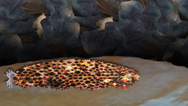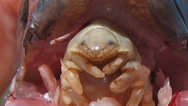The Three-Foot-Long Footworm
- By Anna Rothschild
- Posted 04.09.15
- NOVA
Imagine being infected by a three-foot-long worm that mates in your abdomen and squirts larvae out of a hole in your foot. That's what happens when you have a guinea worm. Luckily, these parasites are close to extinction. Find out how in this episode of Gross Science from NOVA.
Transcript
The Three-Foot-Long Footworm
April 9, 2015
There’s a disease called “dracunculiasis,” which literally means “affliction with little dragons.” Of course, dragons aren’t really involved. You’re actually infected with a three-foot-long worm that mates in your abdomen and squirts larvae out of hole in your foot. You just can’t make this stuff up.
I’m Anna Rothschild, and this is Gross Science.
So, “dracunculiasis” is caused by the guinea worm—a nematode that’s infected humans for millennia and historically has been a major problem in Asia and Africa. People get infected when they drink water that’s been contaminated with tiny water fleas, which house baby guinea worms. The water fleas die when they reach your stomach, but the guinea worm larvae survive, wriggling through your intestinal wall and into your abdomen, where they mate.
After mating, the male guinea worm dies, but the female keeps growing—up to three-feet-long! Over the course of about a year, she burrows through your body, usually ending up near your feet. By that point she’s basically just one big uterus jam-packed with baby worms. When she gets close to the skin, she lets out a little spurt of those larvae, which cause a blister to form.
When the blister bursts, your skin will feel like it’s on fire, so most people try to dunk their feet in water to cool off. And water triggers the female worm’s full-body uterus to rupture, squirting hundreds of thousands of larvae into the water, which might get gobbled up by another flea, beginning the process again.
After all that, you’re still left with a debilitating, three-foot-worm in your foot! And the only way to get rid of a guinea worm is to pull it out very slowly by wrapping it around a rod, being careful not to break it or else it might rot in your body. And this painful process can take weeks.
Guinea worms have been with us for so long that some people think the symbol of medicine—the snake wrapped around the staff—is actually little nod to guinea worm extractions. But, they may not be with us for so much longer. You see, the guinea worms need a human host to reproduce, so just filtering drinking water to keep out the fleas will break their life cycle. In the mid-eighties, there were over three million cases in Asia and Africa, but in 2014 there were only one hundred and twenty six. In fact, they’ll probably be completely gone in the next few years, which will make them the first parasite in the world to be eradicated. And that’s one extinction I could get behind.
Ew.
Credits
PRODUCTION CREDITS:
- Host, Animator, Editor
- Anna Rothschild
- Writer
- Eleanor Nelsen
- DP, Sound, Intern Extraordinaire
- Kristen Clark
MEDIA CREDITS
- Images of Worm Extractions and Water Filtration
- ©The Carter Center
- Dragon
- Chaney Trotter
- Star of Life
- Wikimedia Commons/EMS
- Music: Cool As A Cucumber
- Audio Network
- Cockroaches
- Freesound/StateAardvark
(used with permission from author) - Squeak Pack/squeak_10
- Freesound/Corsica_S
- Swishes
- Freesound/Pogotron
- Produced by WGBH for PBS Digital Studios
SFX
IMAGE
- (main image: Anna and guinea worm
- © WGBH Educational Foundation
Related Links
-

Sea Cucumber Evisceration
Sea cucumbers can expel their internal organs and then regrow them.
-

What Does Disease Smell Like?
Sometimes doctors can diagnose you based on how you smell.
-

The Tongue-Eating Parasite
Gross science: This parasite crawls into a fish's mouth and replaces its tongue. Enough said.
-

16th Century Nose Jobs
Thinking about getting a nose job? Thank goodness it's not the 16th century.

